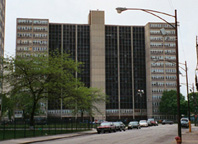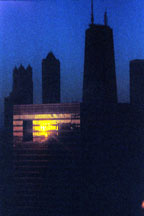|
|
You won't find the stamp of the Chicago architects the rest of the world
recognizes on any of the recent wave of downtown projects. If you want
to see the best of Helmut Jahn, go to the Sony
Center in Berlin. For Adrian Smith at his most ambitious, see the
Jin Mao tower
in Shanghai. There is no lack of talent here, only of will. An old architects'
joke is that for a developer the three most important things are "cheap,
cheaper, and cheapest." But from the look of Chicago's tall buildings
today, that's no longer a punch line--it's a mantra.
While the blame can be laid on a number of doorsteps, one firm can claim
a disproportionate share: Magellan
Development Group, usually in concert with architect James Loewenberg.
The good news is that their projects have gone a  ways
toward restoring the rental market seriously depleted by the condo conversion
boom of the last few decades. The bad news is that they've done it by
populating the city's skyline with a succession of tan boxes of increasing
scale whose chief inspiration appears to be Cabrini-Green's
exposed-concrete towers. ways
toward restoring the rental market seriously depleted by the condo conversion
boom of the last few decades. The bad news is that they've done it by
populating the city's skyline with a succession of tan boxes of increasing
scale whose chief inspiration appears to be Cabrini-Green's
exposed-concrete towers.
Magellan started the current assault small, with projects such as the
Park Newberry
(55 W. Delaware), a 12-story brick-faced condo complex transported from
a 1950s suburban subdivision, and 21
W. Chestnut, a four-plus-one stretched to 17 graceless floors, thankfully
banished to midblock on a side street. But what was merely unfortunate
in these smaller buildings has swollen to the catastrophic in One
Superior Place, completed in 1999. Its 52 floors of unrelieved block-wide
slab, stretching up without setback like a mesa gone mad, suck up skyline
with an obliterating zeal. Tiers of balconies that look like fire escapes
alternate with stumpy columns of windows, creating a facade lacking proportion
and coherence. A mechanical-services plant on the flat roof gives it all
the grace of a Self-Stor warehouse.
Early last year Magellan gave us the even taller Park
Millennium, 57 floors of massing so unattractive that the rental building's
otherwise exhaustive Web site contains not a single picture of its full
profile. Thankfully, from most perspectives the neighboring Hyatt Regency
and Fairmont hotels and the towers of Illinois Center obscure much of
its form, but the concrete-bunker crown still pokes into the skyline like
a giant sore thumb.
Now Magellan is outdoing itself with Grand
Plaza, which occupies the full city block bordered by State, Dearborn,
Grand, and Ohio--a "luxury" development with the demeanor of
a barracks. There are two towers, the taller looming over the nearby AMA
Building by a couple hundred feet. The pedestal takes up every square
inch of the site, rising five floors straight up like a sheer cliff. The
tower facades carry on the Magellan tradition of shallow tiers of balcony
between graceless piers dotted with tiny punch-card windows. The piers
at the southwest and northeast corners are set on a diagonal in a futile
attempt to cut the oppressive blockiness. Louis Sullivan, Chicago's first
truly great architect,  saw
the essential character of a tall building as "proud and soaring...rising
in sheer exultation," but these towers carry their bulk like Willy
Loman carried his sample cases--with an exhausted slouch. Compare them
with Bertrand Goldberg's landmark Marina City corncobs, just a few blocks
south, and you want to weep. saw
the essential character of a tall building as "proud and soaring...rising
in sheer exultation," but these towers carry their bulk like Willy
Loman carried his sample cases--with an exhausted slouch. Compare them
with Bertrand Goldberg's landmark Marina City corncobs, just a few blocks
south, and you want to weep.
Big and bad, Grand Plaza is the most ambitious incarnation yet of the
decline of Chicago architecture. But there seems to be no end to the insipid
boxes: Magellan's 630 N. State Parkway and Admiral's Pointe and Farallon
and Caravel, of course, but also the John Buck Company's Hilton
Garden Inn and Nordstrom's building, to name just a few. Even the
high-end Fordham, from the developer of the same name, is pretty much
the same box wearing a pretty, pointed hat.
In almost all these new projects, the steel-frame construction for which
Chicago skyscrapers were once famous has been replaced by poured-in-place
reinforced concrete, which is substantially cheaper. The material in itself
does not condemn a building to vacuous design--look at Le Corbusier's
Villa Savoye
or Goldberg's River
City. Concrete is an intrinsically plastic medium, yet what all these
new buildings have in common is a complete denial of concrete's unique
properties. They're more relentlessly linear than the most reviled glass
box.
What is the place of a residential tower within an increasingly congested
city center? What is the relation of the tower to the city around it,
and to the life of the street? What is the proper expression of concrete
in a tall building? How does an apartment see? How is it seen? How does
the design feed our hopes? What is its contribution to the fabric of the
city?
From the look of the new buildings, their architects don't even know these
questions exist. But what made Chicago architecture great was how its
practitioners met these issues head-on. Over the century-plus when metal-frame
construction was the primary method for erecting tall buildings, the form
continuously evolved, from the simple brick and terra-cotta of the first
Chicago School in the late 1800s to the more pretentious stone of the
beaux arts revival that followed to the simplified art deco granite of
the 1920s and the eventual triumph of the glass curtain wall in the '60s.
You may love or hate one movement or the other, but you can't deny that
each generation rethought materials, structure, and design for its time.
The beginning was like the reinvention of the world. After the great fire
of 1871, Chicago boomed, and since the center city was tightly confined
by lake and river, ground space was limited. The demand for offices was
not. The only place to go was up. What followed was an unbroken string
of innovations that, one by one, removed the obstacles to constructing
tall buildings.
Did iron melt, buckle, and collapse in the heat of fire? Peter B. Wight
would patent a method of wrapping it in fireproof terra-cotta tiles. Did
tall buildings require foundations so bulky that they ate up huge chunks
of rentable space? John Wellborn Root would lay long strips of rail, crisscrossed
like pickup sticks and encased in concrete to prevent rust, to develop
the inexpensive slab foundation. Were brick and stone too heavy for tall
buildings? William Le Baron Jenney would transfer the weight to a light
skeleton of bolted cast iron and steel to create what many consider the
world's first skyscraper, the Home Insurance Building.
In the Auditorium
Building (now home to Roosevelt University) Adler & Sullivan built
one of the first mixed-use projects, combining an opera house, hotel,
and offices all in one structure. The Masonic
Temple, from Burnham & Root in 1892, was not only the world's
tallest building at the time but anticipated Water Tower Place with its
central light court and nine floors of retail that were not numbered but
named like streets, to make it easier for shoppers to remember store locations.
(It was demolished in 1939.) Holabird & Roche's Tacoma
Building, torn down in 1929 to make way for One North LaSalle, had
so much exterior glass that it could be considered the first use of a
curtain wall.
Then came the fair. The World Columbian Exposition of 1893 would kill
off the first Chicago School and, as predicted by Sullivan, put Chicago
architecture on ice for nearly half a century. Root was to be the fair's
chief designer, and his initial drawings envisioned an architectural showcase
of color and variety. But he died suddenly in 1891, and his partner, Daniel
Burnham, fell under the sway of powerful eastern architects such as Richard
Morris Hunt and McKim Mead & White. Where Chicagoans had created buildings
that frankly expressed their revolutionary iron and steel structure, the
easterners preferred to conceal that structure behind elaborate classical
facades.
As built, the 1893 fair became a stage set for America's imperial ambitions,
a "white city" of exhibition halls masquerading as Roman temples
and palaces, arrayed around a great lagoon traversed by romantic gondolas.
At night, the faux marble glittered under floodlights. It was successful
and influential beyond anyone's dreams. More than 20 million enchanted
visitors spread the word throughout America and across the globe. 
 |
Page: |
|
|
|
|
|
lynnbecker@lynnbecker.com
© Copyright 2003-2004 Lynn
Becker All rights reserved.
|



